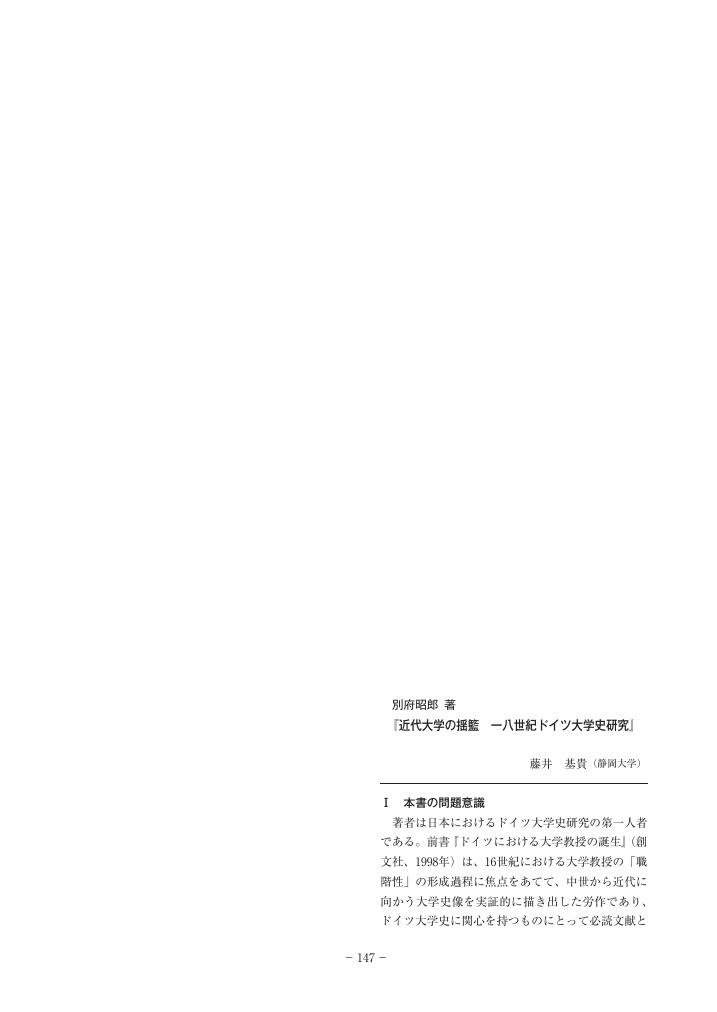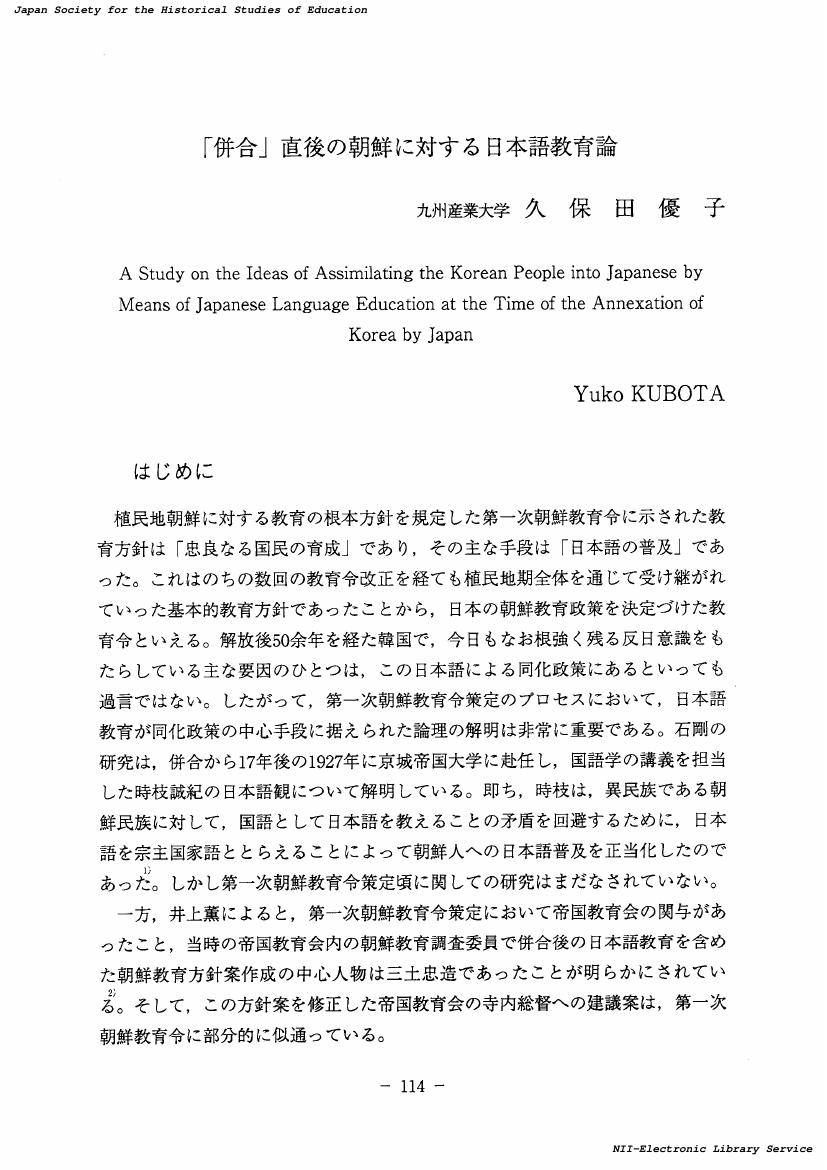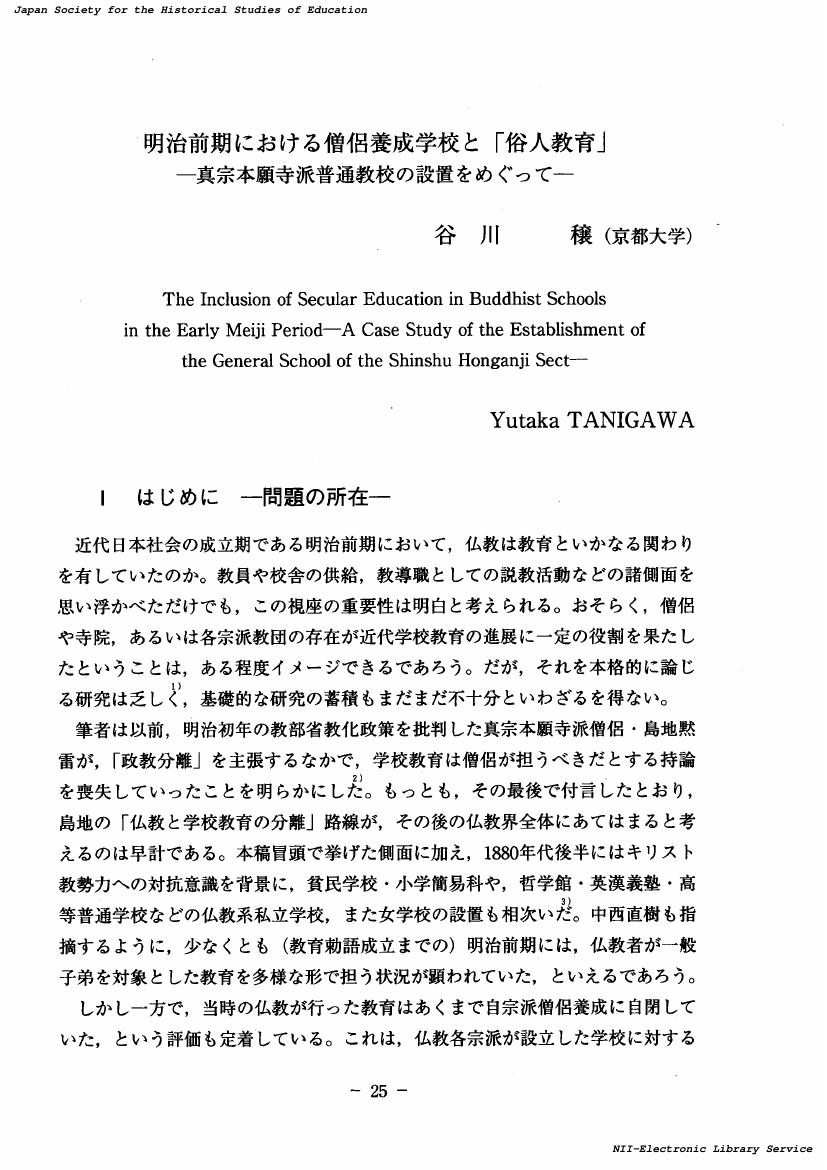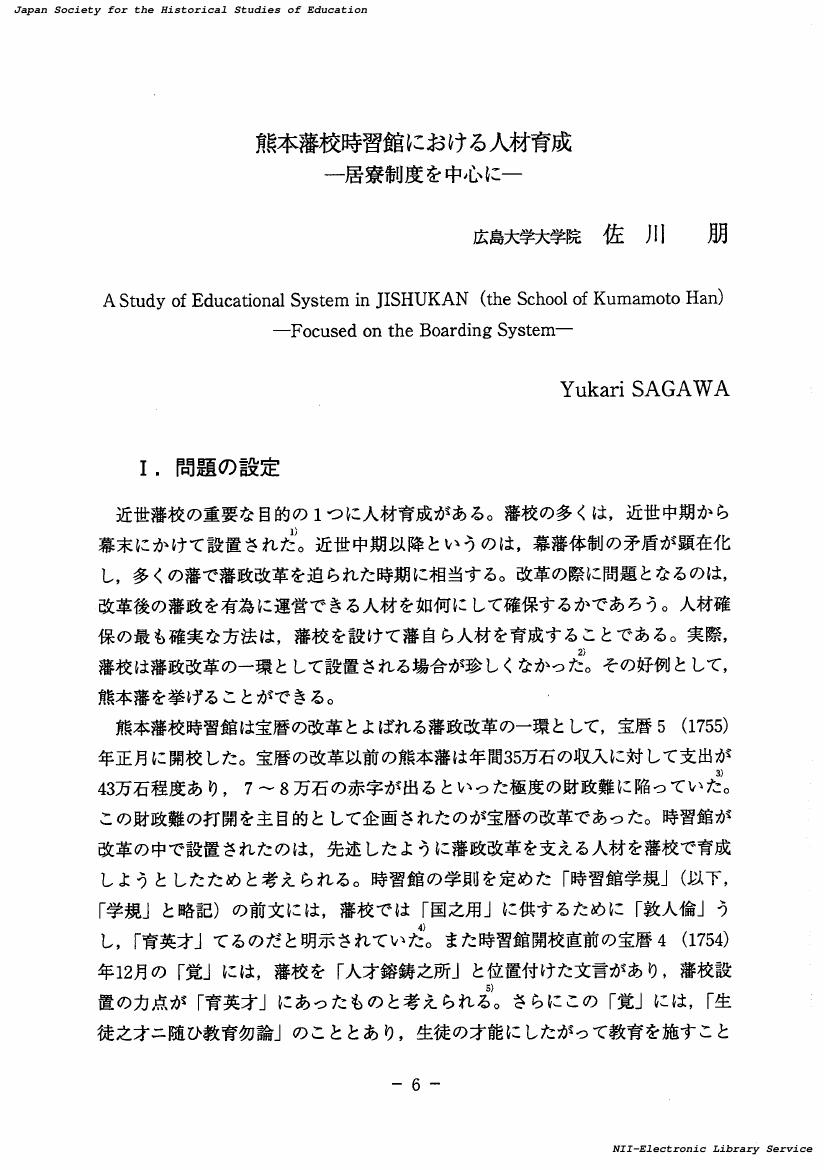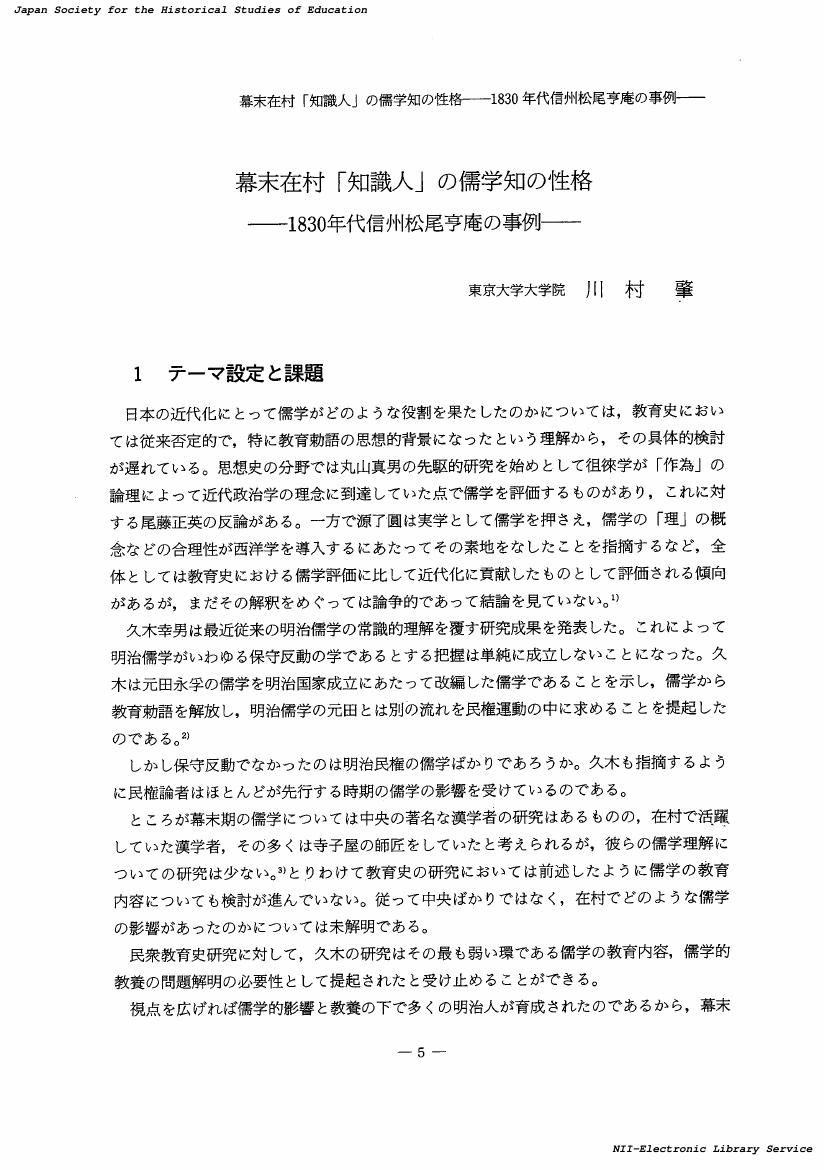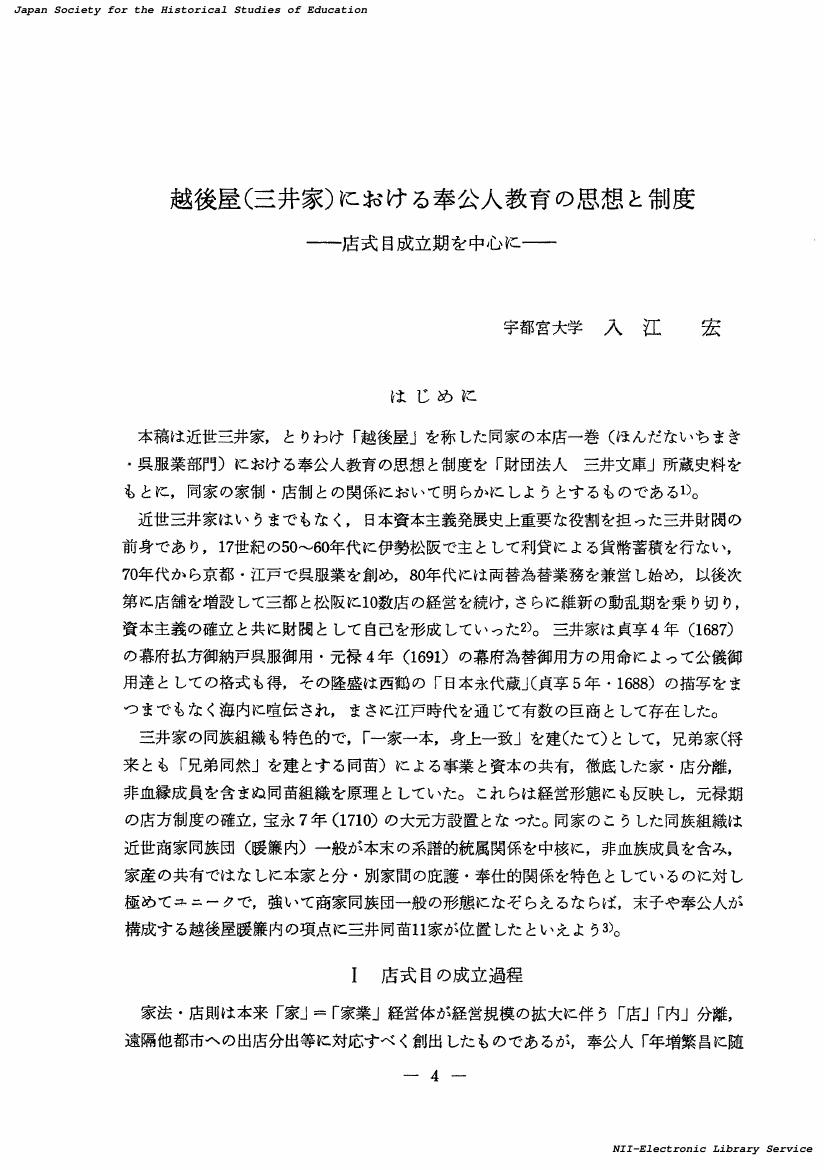2 0 0 0 OA 18世紀ドイツにおける子育ての近代化 : ファウスト『衛生問答』に注目して
- 著者
- 藤井 基貴
- 出版者
- 教育史学会
- 雑誌
- 日本の教育史学 (ISSN:03868982)
- 巻号頁・発行日
- vol.55, pp.85-97, 2012-10-01 (Released:2017-06-01)
Dr. Bernhard Christoph Faust (1755-1842), who played an active role at the end of 18^<th> century as a public health doctor and writer in the field of hygiene, published several revised editions of his book, The Catechism of Health. This book focused on the methods of instructing children how to live a healthy life. The first edition appeared 1792, and Faust revised it in 1794 and again in 1802. This paper analyzes how these texts reflect changes in Faust's views on child rearing. The Catechism of Health makes use of a question-and-answer format in order to teach the knowledge of hygiene. It was designed for the classroom as well as home instruction. This paper elucidates the following issues: (1) How and why Dr. Faust wrote his book and later revisions; (2) Background factors contributing to the book's wide distribution; (3) The main content and revised portions of the book; (4) The changing relationships between the book and the influence of the church; and (5) The changing descriptions of how to put a baby to sleep.
2 0 0 0 OA 女子に対する旧制高等学校の門戸開放 : 敗戦後における制度化の過程を中心として
- 著者
- 大島 宏
- 出版者
- 教育史学会
- 雑誌
- 日本の教育史学 (ISSN:03868982)
- 巻号頁・発行日
- vol.47, pp.109-128, 2004-10-01 (Released:2017-06-01)
The purpose of this study is to define the process of the institutionalization of an open door policy for higher schools (Koto-gakko) to allow girls to attend. In Japan, higher schools had been only for boys until 1947. In the early stages of preparation for "A New General Plan of Female Education Reform", the Ministry of Education had planned to open the door of higher schools to girls. In the plan, girl's special colleges (Joshi-senmon-gakko), higher courses (Koto-ka) and special courses (Senko-ka) of higher girl's schools (Koto-jogakko) would be changed into "girl's higher schools (Joshi-koto-gakko)". However, a difficulty arose in changing girl's special colleges into "girl's higher schools". Also, it became possible for girls to receive a higher school level education through other means. Because of this, in 1946, the Ministry of Education denied the urgent need of an open door policy for higher schools, refusing to qualify girls for entry into higher schools. The revision of the Constitution made it necessary to allow girls to qualify for entry into higher schools. Therefore, the establishment of "higher schools for girls" was once more chosen as the way to open the door of higher schools to girls. However, the plan to reform the school system intended to abolish the higher schools. This made it difficult to carry out an open door policy for higher schools in this way. Eventually, opening the door of higher schools to girls was realized by transforming higher schools into coeducational institutions. The revision of the Constitution required a revision of the purpose (the first) and entrance qualification (the 12th) articles of the imperial ordinance regarding higher schools. However, only the purpose was revised, and entrance qualifications were not. This originates from having tried to deal with the issue of girls' entrance qualification as an exception to the rule.
- 著者
- 渡辺 徳三郎
- 出版者
- 教育史学会
- 雑誌
- 日本の教育史学 (ISSN:03868982)
- 巻号頁・発行日
- vol.1, pp.197-199, 1958-10-10 (Released:2017-06-01)
- 著者
- 麻生 千明
- 出版者
- 教育史学会
- 雑誌
- 日本の教育史学 (ISSN:03868982)
- 巻号頁・発行日
- vol.38, pp.60-77, 1995-10-01 (Released:2017-06-01)
2 0 0 0 OA 明治初期における西洋教育書の翻訳事情 : オランダ人ファン・カステールを中心にして
- 著者
- 橋本 美保
- 出版者
- 教育史学会
- 雑誌
- 日本の教育史学 (ISSN:03868982)
- 巻号頁・発行日
- vol.38, pp.24-40, 1995-10-01 (Released:2017-06-01)
- 著者
- 坂本 紀子
- 出版者
- 教育史学会
- 雑誌
- 日本の教育史学 (ISSN:03868982)
- 巻号頁・発行日
- vol.54, pp.32-44, 2011-10-01 (Released:2017-06-01)
The purpose of this paper is to analyze the elementary education systems that the Hokkaido government put into operation in 1887. The following questions will be addressed through a study of Oyafune town, 9 towns and 3villages in Ishikari district: how did Hokkaido settlers establish and maintain elementary schools under the revised regulations, and what kind of role did these schools play among the settlers? In 1886, the Meiji government reexamined Hokkaido development policy. The next year, the Hokkaido government reformed the elementary education system and issued the following educational ordinances and regulations: regulations of elementary schools and Shogaku-kan'ika, regulation on town and village elementary schools, the official order regarding annual expenses for town and village elementary schools, and the regulation on the establishment change, and abolition of schools. The purpose of many of these regulations was to allow the Hokkaido government save on educational expenses and prioritize industry and development over public education. For this reason, approximately 96% of schools were Shogaku-kan'ika. The characteristic of Shogaku-kan'ika in Hokkaido was different from that of the mainland. The tuition fees were collected and the curriculum included "business exercises." The purpose of Shogaku-kan'ika was not to allow children to attend school, but to promote industry and development, and to secure a steady work force, while abolishing government subsidies, and placing the burden of educational expenses upon the settlers. In actuality, the settlers trying to forge new communities, would not defer educational opportunities school education was indispensable in the formation of the community. In addition, most settlers expected the establishment of elementary schools and upper elementary schools. For Hokkaido's inhabitants, schools were a symbol of the-"development" -of their new community. In this way, when the history of education in Hokkaido is separated from the reality of communities, we see that the education system that the Hokkaido government established was unsuitable to the actual circumstances of Hokkaido settlers. The people of Hokkaido actually paid for the bulk of school expenditures including their establishment and maintenance. By understanding this, the history of education in Hokkaido under modern Japan's Hokkaido development policy becomes clear.
- 著者
- 岩田 高明
- 出版者
- 教育史学会
- 雑誌
- 日本の教育史学 (ISSN:03868982)
- 巻号頁・発行日
- vol.49, pp.19-31, 2006
This article analyzes information on Western education contained in several records, namely "A British Inquiry," "A Dutch Inquiry," "A French Inquiry," "A Prussian Inquiry," and "A Portuguese Inquiry" (called collectively "A European Inquiry" hereafter), found in The Notes of Fukuda Sakutaro (27 vols.). This work, housed in the Historiographical Institute The University of Tokyo, was recorded during the Tokugawa shogunate's 1861 mission to Europe. This article discusses the following : 1. The legation of the 1861 mission and the inquiry into European educational systems; 2. The participation of Mitsukuri Genpo in the inquiry into European educational systems ; 3. Circumstances surrounding the composition of The Notes of Fukuda Sakutaro ; 4. Information about the establishment of schools and forms of administration as described in "A European Inquiry ;" 5. Information about national educational systems as described in "A European Inquiry;" 6. Information about schools of every country visited during the Mission as described in "A European Inquiry." There are five particular points made in this article. First, The Notes of Fukuda Sakutaro has not been used as a source prior to this, with the exception of "A British Inquiry," published in Seiyo Kenbunshu (A Collection of Observations of the West), in Nippon Shiso Taikei. vol. 66. Second, it was exactly ten years later that the new Meiji Ministry of Education followed in the footsteps of the Tokugawa Shogunate and began its own investigation of educational systems. The 1861 mission, in addition to its primary function of improving foreign relations, included an inquiry into European matters, under orders to "conduct an investigation into each nation's government, educational system, and military organizations with particular care." In other words, the 1861 mission was Japan's first investigation into the state of Western education, and "A European Inquiry" was the formal report. Third, it was likely because of the involvement of Mitsukuri Genpo, chief instructor of the shogunate's Bureau of Western Learning, that educational systems came to be the most important topic for the 1861 mission's inquiries. At that time, Mitsukuri Genpo, with his strong connections to shogunal leaders, was the scholar most familiar with Western education through his knowledge of Dutch and Chinese translations of foreign books. Fourth, this article discusses the analysis of the surveys of various European countries included in "A European Inquiry," on topics like the establishment of schools and the forms of administration, administrative and educational expenses. Fifth, this paper analyzes information regarding various European states' national educational systems. Information about countries with more fully developed systems, namely Prussia and the Netherlands, is particularly abundant.
2 0 0 0 OA 別府昭郎 著 『近代大学の揺籃 一八世紀ドイツ大学史研究』
- 著者
- 藤井 基貴
- 出版者
- 教育史学会
- 雑誌
- 日本の教育史学 (ISSN:03868982)
- 巻号頁・発行日
- vol.58, pp.147-150, 2015 (Released:2016-05-02)
2 0 0 0 OA (1)洋算教育の成立過程
- 著者
- 川本 亨二
- 出版者
- 教育史学会
- 雑誌
- 日本の教育史学 (ISSN:03868982)
- 巻号頁・発行日
- vol.7, pp.1-22, 1964-10-30 (Released:2017-06-01)
Whatever is called "arithmetic" in our present system of school education is "yozan" (western arithmetic). This dates back to 1872, when it took the place of "wazan" (Japanese arithmetic) which is quite peculiar to our country. The present thesis is intended as a brief inquiry into the process of the pervasion of yozan in our school system. Yozan came to be known in Japan as early as the first half of 18th century, in close connection with the coming of the western knowledges of astronomy, tactics and so on. But it was mainly via China through the Chinese translations. The visit of American warships in 1853 was really an epoch-making event in the history of yozan in Japan. Yozan, which had been considered only as useful against the crisis of the domestic economy, came to be regarded as "necessary" for surmounting the diplomatic crisis. It is only then that the systematic teaching of yozan began in our country. It was launched out at the Nagasaki Naval Academy (1855-59), where yozan was regarded as the most important basic knowledge for all military sciences. In Hanko (educational institution for the military class), there had been a tendency toward neglecting arithmetic, even wazan. But as the problem of national defense became urgent after the visit of the American warships, yozan began to be taught at some Hanko. To most Terakoya (private school for the lower class), however, yozan gave no great influence worth mentioning, except a few where it was taught in compliance with the pupils' request. Though yozan had thus given quite a limited influence on our school education, it was decided in 1872 in the code entitled "Gakusei" that only yozan should be taught as "arithmetic" at every school in Japan. The aim of Gakusei was, first of all, the rapid growth of Japan into one of the advanced countries. In this sense, it seems natural that we have accepted yozan as our only "arithmetic", following other advanced countries. But it shouldn't be regarded only as a matter of imitation. The largest motive of our having accepted yozan lay in the then urgent desire for the increase of our defensive power which is eloquently expressed in the active attitude of the Nagasaki Naval Academy toward the introduction of tactics. Preference of yozan to wazan came in fact more from the need of national defense than from any academic comparison between them. In other words, the western knowledge which was indispensable in our national defense couldn't be learned efficiently without western methods of calculation and description. "The western arithmetic for learning the western knowledge" this was what made us prefer yozan to our old wazan.
2 0 0 0 朝鮮神宮と学校 : 勧学祭を中心に
- 著者
- 樋浦 郷子
- 出版者
- 教育史学会
- 雑誌
- 日本の教育史学 (ISSN:03868982)
- 巻号頁・発行日
- vol.49, pp.110-122, 2006
During the prewar era, many Japanese shrines were built in Japan's colonies, such as Korea and Taiwan. This paper examines the problem of forcing the local residents to go and pay homage to the shrines and to worship the Japanese imperial deities that were supposedly housed therein. The focus of this paper is how Chosen Jingu, built in 1925 and established as a highly-ranked shrine in the Japanese shrines hierarchy, and schools collaborated together to compel elementary school students to visit the shrine. In order to analyze this issue, this paper will examine the case of Kangakusai, one of Chosen Jingu's rituals. In Kangakusai, Chosen Jingu distributed moral training textbooks (Shushin) for first graders in almost all elementary schools in Keijo district, where Chosen Jingu was located. All of the students who received a textbook from the shrine had to go there in order to thank the imperial deities. This shows how shrine rituals like Kangakusai played an important role in the compulsion of students' worship at Chosen Jingu. Behind the enforcement of Kangakusai, one finds the leadership of the chief priests of Chosen Jingu, such as Takamatsu Shiro. In explaining what Takamatsu and other priests did, this paper demonstrates the active role played by shrine priests. They did not merely follow Japanese Government General directives but took a leading role at times in the enforcing the "Japanization" of Koreans. In addition, the mutual reinforcing relationship between shrines and schools enabled primary school students to be the most influenced sector of Korean society. In Japan, much research on colonial shrines focus on the compulsion of shrine worship from the late 1930s to 1945. However, this issue did not begin in the 1930s. This paper seeks to shed additional light on colonial shrine worship prior to the 1930s through an analysis of Kangakusai.
2 0 0 0 1930年代の公立職業学校における女子教育
- 著者
- 徳山 倫子
- 出版者
- 教育史学会
- 雑誌
- 日本の教育史学 (ISSN:03868982)
- 巻号頁・発行日
- vol.59, pp.45-57, 2016
<p>This article places public vocational schools (Shokugy<span style="text-decoration: overline;">o</span>-Gakk<span style="text-decoration: overline;">o</span>) for girls within the context of the history of women's education by analyzing the education of girls at Sano Higher Practical School for Girls (Sano K<span style="text-decoration: overline;">o</span>t<span style="text-decoration: overline;">o</span> Jissen Jogakk<span style="text-decoration: overline;">o</span>) in Osaka Prefecture.</p><p>In the rural areas of Osaka Prefecture during the 1930's, public vocational schools for girls were established as an alternative to public girls' high schools (K<span style="text-decoration: overline;">o</span>t<span style="text-decoration: overline;">o</span> Jogakk<span style="text-decoration: overline;">o</span>). In the 1940's, most of these vocational schools were converted into girls' high schools. Sano Higher Practical School for Girls was one of them.</p><p>Sano Higher Practical School for Girls taught many of the same subjects as the girls' high schools, but devoted more hours to sewing. Some graduates of the vocational school married immediately after graduation, others were employed at department stores, train stations, or in other fields, while others continued to train in sewing as preparation for marriage. The students in vocational schools regarded the students of the girls' high schools with admiration and a sense of competitiveness. Students, their parents, and graduates wished for the vocational school to become a standard girls' high school.</p><p>In the 1930's, vocational schools were part of the increase in public secondary schools. They were training schools intended to promote the ideal of "Ry<span style="text-decoration: overline;">o</span>sai kenbo", as were girls' high schools. While the purpose of vocational and high schools were similar, vocational schools devoted more hours to sewing and held lower social status. Eventually vocational schools were promoted to girls' high schools.</p>
1 0 0 0 OA 「併合」直後の朝鮮に対する日本語教育論
- 著者
- 久保田 優子
- 出版者
- 教育史学会
- 雑誌
- 日本の教育史学 (ISSN:03868982)
- 巻号頁・発行日
- vol.42, pp.114-131, 1999-10-01 (Released:2017-06-01)
1 0 0 0 OA 植民地朝鮮の普通学校教育における朝鮮語の位置づけ
- 著者
- 山田 寛人
- 出版者
- 教育史学会
- 雑誌
- 日本の教育史学 (ISSN:03868982)
- 巻号頁・発行日
- vol.41, pp.134-151, 1998-10-01 (Released:2017-06-01)
1 0 0 0 OA (6)ナポレオン学制における宗教教育
- 著者
- 西出 不二雄
- 出版者
- 教育史学会
- 雑誌
- 日本の教育史学 (ISSN:03868982)
- 巻号頁・発行日
- vol.10, pp.127-148, 1967-09-30 (Released:2017-06-01)
In this article, I intend to consider the relation between Napoleon Bonaparte and the Roman Catholic Church, in order to analyse the characteristics of the religious education in the reign of Napoleon (1799-1815). Immediately after the "coup d'Etat du 18 Brumaire", Napoleon pursued the secular policy as leaders of the French Revolution had done, with respect to religious problem. But Napoleon concluded the "Concordat" with Pius VII, in conformity with the rebirth of a religious atmosphere after the French Revolution. As a result, the religious education was put into practice. Although Napoleon admitted educational action under the direction of the Church, his real intention was to make full use of its traditional authority and organization to serve his regime. Thus, applying the "Articles organiques" to the Church, Napoleon tried to oppress the private schools which contradicted his policies. The Church only had a seminary in each diocese, but the Catholic clergy was occupied in the educational action out of surveillance of the government. That was why Napoleon could not take the "liberte d'enseignement" from the Church. It was a centralism like "patriarcat national" that Napoleon proposed to realize, for he would become a souvereign of both realms: spiritual and temporal. For that purpose, he took two effective measures in 1806. One was to distribute the uniform catechism in which Napoleon emphasized his power, and the other was to found the "Universite imperiale" as a convenient organ to penetrate his will. Napoleon could scarecely attain his purpose in reality. However we can find, in the process of the keen conflicts about religion and moral between Napoleon and the Church, a fundamental subject in the history of French education.
1 0 0 0 OA 明治前期における僧侶養成学校と「俗人教育」 : 真宗本願寺派普通教校の設置をめぐって
- 著者
- 谷川 穣
- 出版者
- 教育史学会
- 雑誌
- 日本の教育史学 (ISSN:03868982)
- 巻号頁・発行日
- vol.46, pp.25-43, 2003-10-01 (Released:2017-06-01)
1 0 0 0 OA 熊本藩校時習館における人材育成 : 居寮制度を中心に
- 著者
- 佐川 朋
- 出版者
- 教育史学会
- 雑誌
- 日本の教育史学 (ISSN:03868982)
- 巻号頁・発行日
- vol.40, pp.6-21, 1997-10-01 (Released:2017-06-01)
1 0 0 0 OA 第一回万国道徳教育会議における日本政府参加の経緯と影響関係
- 著者
- 平田 諭治
- 出版者
- 教育史学会
- 雑誌
- 日本の教育史学 (ISSN:03868982)
- 巻号頁・発行日
- vol.34, pp.97-110, 1991-10-01 (Released:2017-06-01)
1 0 0 0 OA 明治初年の民政改革における〈教育〉の台頭 ―大木喬任と学制―
- 著者
- 湯川 文彦
- 出版者
- 教育史学会
- 雑誌
- 日本の教育史学 (ISSN:03868982)
- 巻号頁・発行日
- vol.58, pp.6-18, 2015 (Released:2016-05-02)
- 参考文献数
- 8
This paper examines the essential qualities of educational policy during the early Meiji Period, focusing on the relation between education and the reform of Civil Government. Previous studies of Meiji educational system and policy regard Education System Order of 1872 as the starting point of modern educational policy, and assessed the Order itself as a product of intellectualism and literal translation of Western knowledge, and therefore undifferentiated, unrealistic, and/or arbitrary in nature. However, these studies did not consider the real intent and actions of officials involved in determining educational policy, particularly those of Oki Takato, who was the primary educational policymaker of the early Meiji period. Through an analysis of Oki Takato’s intent and actions, this study provides context for early Meiji educational policy, Education System Order of 1872, and educational policy. The results are as follows: 1) Oki recognized the importance of education for all people, through Civil Government in Tokyo Prefecture. He determined the order of importance for various matters of Civil Government, and carried them out, step by step, in a practical manner. He was appointed to the Ministry of Civil Government (Minbusho) by the Meiji government, and considered how to encourage all people to understand the benefits of learning, and insisted that it was very important to establish elementary schools, to provide learning opportunities for girls, as well as opportunities for learning business methods throughout Japan. 2) For Oki, the first Minister of Education, Education System Order of 1872 was nothing more than a first step. After it was promulgated, he immediately suggested that it should be revised, based on local government officials’ input, and re-emphasized that the top priority was the establishment of elementary schools.
1 0 0 0 OA 幕末在村「知識人」の儒学知の性格 : 1830年代信州松尾亨庵の事例
- 著者
- 川村 肇
- 出版者
- 教育史学会
- 雑誌
- 日本の教育史学 (ISSN:03868982)
- 巻号頁・発行日
- vol.33, pp.5-19, 1990-10-27 (Released:2017-06-01)
1 0 0 0 OA 越後屋(三井家)における奉公人教育の思想と制度 : 店式目成立期を中心に
- 著者
- 入江 宏
- 出版者
- 教育史学会
- 雑誌
- 日本の教育史学 (ISSN:03868982)
- 巻号頁・発行日
- vol.13, pp.4-20, 1970-10-05 (Released:2017-06-01)



